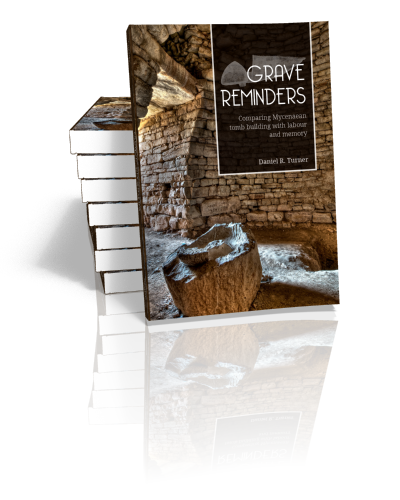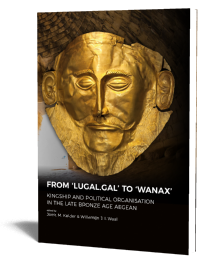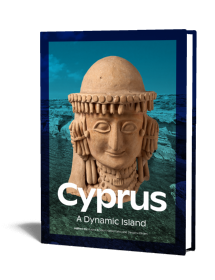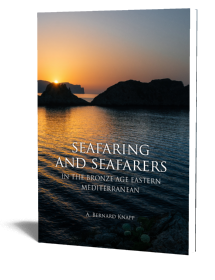Grave Reminders
Comparing Mycenaean tomb building with labour and memory
Daniel R. Turner | 2020

Grave Reminders
Comparing Mycenaean tomb building with labour and memory
Daniel R. Turner | 2020
Paperback ISBN: 9789088909832 | Hardback ISBN: 9789088909849 | Imprint: Sidestone Press Dissertations | Format: 182x257mm | 310 pp. | Language: English | 110 illus. (bw) | 36 illus. (fc) | Keywords: Mycenae; mortuary practice; 3D modelling; Greek archaeology; collective memory; architectural energetics; Aegean Bronze Age; chamber tombs | download cover
Read online or downloaded 1359 times
-
Digital & Online access
This is a full Open Access publication, click below to buy in print, browse, or download for free.
-
Buy via Sidestone (EU & UK)
-
Buy via our Distributors (WORLD)
For non-EU or UK destinations you can buy our books via our international distributors. Although prices may vary this will ensure speedy delivery and reduction in shipping costs or import tax. But you can also order with us directly via the module above.
UK international distributor
USA international distributor
-
Bookinfo
Paperback ISBN: 9789088909832 | Hardback ISBN: 9789088909849 | Imprint: Sidestone Press Dissertations | Format: 182x257mm | 310 pp. | Language: English | 110 illus. (bw) | 36 illus. (fc) | Keywords: Mycenae; mortuary practice; 3D modelling; Greek archaeology; collective memory; architectural energetics; Aegean Bronze Age; chamber tombs | download cover
Read online or downloaded 1359 times

We will plant a tree for each order containing a paperback or hardback book via OneTreePlanted.org.
From ca. 1600 – 1000 BC, builders across southern Greece crafted thousands of rock-cut chamber tombs similar to earlier and contemporary ‘beehive’ tholos tombs. Both tomb styles were designed with multiple uses in mind, filling with the remains of funerals forgotten over generations of reuse. In rare cases, the tombs were used once or seemingly not at all, cleaned thoroughly or sealed and abandoned entirely. Rather than focus on the missing or muddled record of funeral and post-funeral activities, this book re-examines Mycenaean tomb architecture and the decisions that guided it.
From minimalistic to monumental, builders designed tombs with forethought to how commissioners and witnesses would react and remember them. Patterns suggest that memories of what tombs should look like heavily influenced new construction toward recurring shapes and appropriate scales. The wider debates over cost from ‘architectural energetics’ and perception in Aegean mortuary behaviour are thus revisited. Both can find common purpose in labour measured through a relative index and collective memory – how labourers and patrons saw their work. That metric for comparison lies within a median standard: in this instance, tombs expressed in terms of correlative shape and simple labour investment of the earth and rock moved to create them. This was accomplished here through photogrammetric modelling of 94 multi-use tombs in Achaea and Attica, verifying a cost-effective alternative for local authorities warding off information loss through site destruction from looting and earthquakes. Since most labour models suggest the tombs were not burdensome, commissioners held extravagant building in check by weighing the social risks and rewards of standing out from the crowd.
Preface
Acknowledgements
List of Figures
List of Tables
Chapter 1. Introduction
1.1. Place and purpose
1.2. Case studies and reasoning
1.3. Advancing objectives: comparative labour and grave reminders
1.4. Forecast: from catalogue blueprints to transient experience
Chapter 2. Setting
2.1. Mycenaean tomb development
2.2. The rock canvas
2.2.1. Physiography of southern Greece
2.2.2. Soil mechanics and risks
2.3. Sponsor’s gamble
2.3.1. Costly signalling with tombs
2.3.2. Risks of investment: the expected standard
2.3.3. Cost and altruism in cooperative labour
2.4. Summary
Chapter 3. Artists at work: perspectives and logistics in cooperative building
3.1. Construction planning and alignment
3.2. Further projections on time constraints
3.3. Tracking progress from household to cooperative labour
3.3.1. Preindustrial construction logistics
§ Planning and guidance § Support § Gendered work § Scheduling § Mechanics
3.3.2. Labour rates
§ Procurement § Transport § Placement § Reuse
3.4. Measuring success
3.4.1. Modelling tombs with photogrammetry
§ Alternate data collection
3.4.2. Finding sameness with Euclidean distance
§ AA01 standard and the Tomb Relative Index (TRex)
3.5. Summary
Chapter 4. A labour catalogue with multi-use tombs
4.1. Menidi
4.2. Portes
4.3. Voudeni
4.4. Summary
Chapter 5. Reminders
5.1. Building legacy in the early LH
5.2. End-stage from LH IIIC Achaea
5.3. Interpreting tomb scale and sameness
5.4. Labouring toward forgetting
5.5. Concluding summary
References Cited
Appendix 1. Labour rates
Appendix 2. Other tombs
Appendix 3. Digital collection of excess tomb models

Dr. Daniel R. Turner
Daniel R. Turner holds a B.A. in Anthropology from the University of Alabama (2010) with specialisations in medieval history and the archaeology of complex societies. He received an M.Phil. in Archaeological Research from the University of Cambridge (2012) after completing a dissertation on comparative labour costs of early medieval earthworks in the British Isles. From 2012 to 2015, he served as a Staff Archaeologist for the cultural resource management firm, Panamerican Consultants, Inc. (PCI), directing more than 60 surveys and excavations across the south-eastern U.S. In 2016, he joined the ERC-funded SETinSTONE project as a PhD candidate within the Faculty of Archaeology at Leiden University, continuing with the project as a postdoctoral researcher in early 2020.
Abstract:
From ca. 1600 – 1000 BC, builders across southern Greece crafted thousands of rock-cut chamber tombs similar to earlier and contemporary ‘beehive’ tholos tombs. Both tomb styles were designed with multiple uses in mind, filling with the remains of funerals forgotten over generations of reuse. In rare cases, the tombs were used once or seemingly not at all, cleaned thoroughly or sealed and abandoned entirely. Rather than focus on the missing or muddled record of funeral and post-funeral activities, this book re-examines Mycenaean tomb architecture and the decisions that guided it.
From minimalistic to monumental, builders designed tombs with forethought to how commissioners and witnesses would react and remember them. Patterns suggest that memories of what tombs should look like heavily influenced new construction toward recurring shapes and appropriate scales. The wider debates over cost from ‘architectural energetics’ and perception in Aegean mortuary behaviour are thus revisited. Both can find common purpose in labour measured through a relative index and collective memory – how labourers and patrons saw their work. That metric for comparison lies within a median standard: in this instance, tombs expressed in terms of correlative shape and simple labour investment of the earth and rock moved to create them. This was accomplished here through photogrammetric modelling of 94 multi-use tombs in Achaea and Attica, verifying a cost-effective alternative for local authorities warding off information loss through site destruction from looting and earthquakes. Since most labour models suggest the tombs were not burdensome, commissioners held extravagant building in check by weighing the social risks and rewards of standing out from the crowd.
Contents
Preface
Acknowledgements
List of Figures
List of Tables
Chapter 1. Introduction
1.1. Place and purpose
1.2. Case studies and reasoning
1.3. Advancing objectives: comparative labour and grave reminders
1.4. Forecast: from catalogue blueprints to transient experience
Chapter 2. Setting
2.1. Mycenaean tomb development
2.2. The rock canvas
2.2.1. Physiography of southern Greece
2.2.2. Soil mechanics and risks
2.3. Sponsor’s gamble
2.3.1. Costly signalling with tombs
2.3.2. Risks of investment: the expected standard
2.3.3. Cost and altruism in cooperative labour
2.4. Summary
Chapter 3. Artists at work: perspectives and logistics in cooperative building
3.1. Construction planning and alignment
3.2. Further projections on time constraints
3.3. Tracking progress from household to cooperative labour
3.3.1. Preindustrial construction logistics
§ Planning and guidance § Support § Gendered work § Scheduling § Mechanics
3.3.2. Labour rates
§ Procurement § Transport § Placement § Reuse
3.4. Measuring success
3.4.1. Modelling tombs with photogrammetry
§ Alternate data collection
3.4.2. Finding sameness with Euclidean distance
§ AA01 standard and the Tomb Relative Index (TRex)
3.5. Summary
Chapter 4. A labour catalogue with multi-use tombs
4.1. Menidi
4.2. Portes
4.3. Voudeni
4.4. Summary
Chapter 5. Reminders
5.1. Building legacy in the early LH
5.2. End-stage from LH IIIC Achaea
5.3. Interpreting tomb scale and sameness
5.4. Labouring toward forgetting
5.5. Concluding summary
References Cited
Appendix 1. Labour rates
Appendix 2. Other tombs
Appendix 3. Digital collection of excess tomb models

Dr. Daniel R. Turner
Daniel R. Turner holds a B.A. in Anthropology from the University of Alabama (2010) with specialisations in medieval history and the archaeology of complex societies. He received an M.Phil. in Archaeological Research from the University of Cambridge (2012) after completing a dissertation on comparative labour costs of early medieval earthworks in the British Isles. From 2012 to 2015, he served as a Staff Archaeologist for the cultural resource management firm, Panamerican Consultants, Inc. (PCI), directing more than 60 surveys and excavations across the south-eastern U.S. In 2016, he joined the ERC-funded SETinSTONE project as a PhD candidate within the Faculty of Archaeology at Leiden University, continuing with the project as a postdoctoral researcher in early 2020.
-
Digital & Online access
This is a full Open Access publication, click below to buy in print, browse, or download for free.
-
Buy via Sidestone (EU & UK)
-
Buy via our Distributors (WORLD)
For non-EU or UK destinations you can buy our books via our international distributors. Although prices may vary this will ensure speedy delivery and reduction in shipping costs or import tax. But you can also order with us directly via the module above.
UK international distributor
USA international distributor
- Browse all books by subject
-
Search all books

We will plant a tree for each order containing a paperback or hardback book via OneTreePlanted.org.
You might also like:
© 2025 Sidestone Press KvK nr. 28114891 Privacy policy Sidestone Newsletter Terms and Conditions (Dutch)








